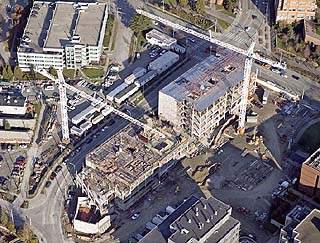
DJC.COM
March 17, 2005
Even labs can cut lighting costs
Candela

Frazier
|
From an architectural standpoint, daylighting is simply the admittance of natural light into a building's interior. When we think of daylighting in a green building, however — including laboratories — we expect a configuration more complex in function and installation.
Like most building types, laboratories are increasingly using principles of sustainable design. As energy requirements for technology in laboratories increase at a steady rate, there is good reason to consider reducing the energy used by lighting. Daylighting is the single best way to achieve this goal while promoting green building design.
Daylighting for safety
The 2002 Seattle Supplement to the Washington State Energy Code requires that light fixtures located within daylit zones of a building be automatically controlled in response to available daylight. Complying with this requirement can reap substantial savings, particularly if the building is designed in accordance with good daylighting practice.

Photo courtesy of Anshen + Allen, LA
|
Several laboratory buildings that have been designed and erected since this code went into effect have been granted exceptions based on perceived safety issues. The thinking is that if someone is carrying a toxic or corrosive substance at the same time the light level suddenly drops by a third or half, the person may be startled and drop the substance. This is a serious consideration, but one that can be addressed with appropriate equipment.
The University of Washington's Bioengineering and Genome Sciences Building, scheduled to open in 2006, responded to the safety issue by planning for automatic dimming daylight controls in all daylit laboratory spaces. UW's quest to reduce energy costs was a driving factor in the process, as was the design team's commitment to sustainable design principles.
Energy and controls
Automatic lighting controls are the means by which energy use is reduced in a daylit building. Daylighting control systems can be designed to react to daylight by either switching off some of the lamps or by dimming them.
The light output from the fixture responds to the changes in daylight, but not to jumps in light levels due to the lighting equipment. The system is designed to not overreact, which would cause noticeable swings in light levels.
The simplest dimming daylighting control system consists of a light sensor that communicates directly with a group of fluorescent dimming ballasts.
This is the type of system employed at the UW Bioengineering and Genome Sciences Building. The ballast in each fixture responds to the signal from the light sensor by raising or lowering the light output from all of the lamps powered by that ballast.
The design of the daylighting system in these buildings was constrained by the orientation of the site, long in the north-south axis rather than the preferred east-west axis. However, Anshen+Allen, the architect, responded to the different conditions on the four sides of the buildings with design elements that enhance daylight penetration and provide sun shading.
The lighting design in the laboratories consists of semi-recessed direct/indirect fluorescent fixtures, in rows perpendicular to the exterior glazing. Two out of three lamps in the fixtures within the daylight zones have dimming ballasts that respond to ceiling-mounted light sensors. These light sensors read the light level on a workbench and adjust the output of the fixture accordingly.
Those who will work in the laboratories were included in the decision-making process to ensure their concerns were addressed. It is critical to engage users when these systems are in the early stages of design. Scientists are smart, observant people. They will find a way to override controls if they don't like them, and these are expensive systems to build and then disable.
Learning to coordinate
Locating the light sensors in a laboratory space is a process of negotiation. Lab ceilings are precious real estate, and equipment and instrumentation is very carefully located to fit everything in. Architects want to organize all the equipment so that the ceiling looks orderly.
Light sensors have specific requirements that must be met in order to have them operate properly. To achieve the optimum solution, everyone has to play nice.
These controls must be correctly designed, located, calibrated and maintained in order to work properly. The light sensors have historically been the weak link in the system, but the technology is improving and becoming more user-friendly.
As more contractors understand the requirements for the equipment, and as better-informed owners demand that systems function properly and remain well-maintained, these issues will be resolved.
Dimming saves energy
The common impression is that switched controls cost substantially less than dimmed controls, and are more reliable. This impression was true once, but no longer.
Not only are dimming ballasts now less costly, fewer ballasts and relays are needed for a dimmed system than a switched system. Contractors are educating themselves about the technology and reducing their installation cost as a result. Dimming ballasts are also more reliable than they were 10 years ago. The technology has arrived and succeeded.
Most analyses show that dimmed controls save more energy over time than switched controls.
With switched controls, the savings don't start until the daylight provides light levels equal to the first step in the switching pattern.
Savings can only be accurately predicted for a particular building design on a specific site. Light level requirements for laboratories are high relative to other building types, and tolerance for glare is much lower. Savings will not be as great for labs as buildings like big-box retail, where skylights can flood a space with light. But a range of savings from 0 percent to 40 percent can be achieved with careful design and maintenance.
Making it work
As we bring knowledge of sustainable design strategies to the table, we contribute significant value to the design of green buildings, including laboratories.
The success of green buildings depends on an integrated design process that incorporates holistic thinking and cross-discipline innovation. The key is to remember that we are all part of a design team rather than individual experts.
Mary Claire Frazier is principal at Candela Architectural Lighting Consultants in Seattle.
Other Stories:
- How to fit green into your budget
- Time for marketing and sales people to go green
- Hospitals are making strides toward sustainability
- Seattle can show the world how to be green
- Green multifamily? Here's how to get started
- Seattle schools offer lessons in green
- You can build green without showing off
Copyright ©2009 Seattle Daily Journal and DJC.COM.
Comments? Questions? Contact us.